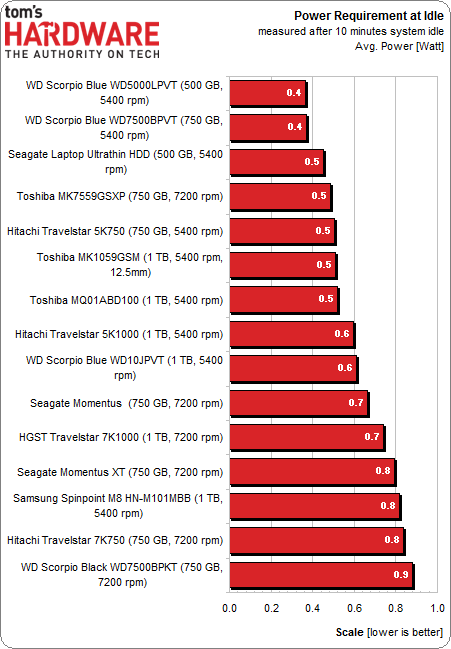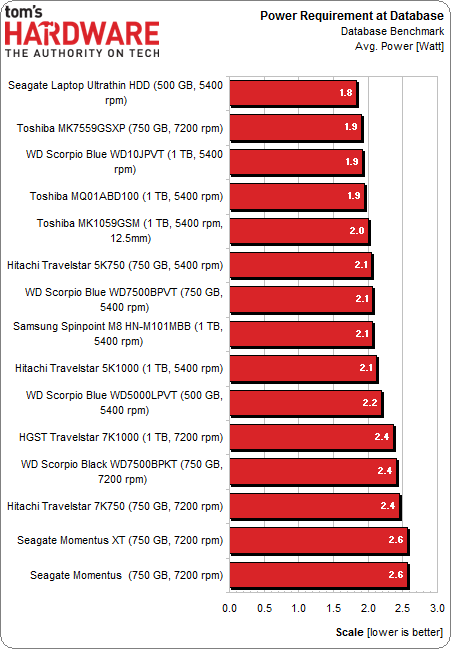Seagate Laptop Ultrathin HDD Review: 500 GB In 5 mm Of Space
When you look at it from the side, Seagate's Laptop Ultrathin HDD is almost easy to miss. Measuring just 5 mm tall, it’s one of the thinnest hard drives in existence. We got our hands on the 500 GB model to see if it can keep up with larger disks.
Results: Power Consumption And Efficiency
Power Consumption
The Laptop Ultrathin HDD’s read and write results turn out to be thoroughly average (which isn't bad for a product designed for constrained dimensions, not for blazing speed). But its power consumption is another story entirely. Since the 5 mm drive only has one platter to spin, it doesn't burn a lot of juice. Seagate posts good numbers overall, not always topping the charts, but certainly trending higher than it did in the performance benchmarks, drawing between 0.5 W at idle and 2.7 W at maximum data transfer speed.
Efficiency
The ratio of performance to power consumption gives us some insight into each hard drive's efficiency, and the usage scenarios to which they're best suited. The streaming writes and database efficiency of Seagate's Laptop Ultrathin HDD are top-of-the-line compared to other 2.5" products spinning at 5400 RPM.
Get Tom's Hardware's best news and in-depth reviews, straight to your inbox.
Current page: Results: Power Consumption And Efficiency
Prev Page Results: PCMark 7 Next Page A Good Choice For Small Laptops And Ultrabooks-
razor512 For the hard drive being benchmarked, is it possible for tomshardware to color the text to make them easier to find in the list?Reply
for example http://i.imgur.com/VXwTs6y.jpg
it only takes about 3 seconds to do (even faster if you are in the process of making the chart and not changing colors in post) -
Someone Somewhere ReplyIts main selling point is the fact that it's only 5 mm thick, instead of the 9.5"
Think you meant 9.5mm there.
At least it's not got proprietary connectors like the WD 5mm ones do. Think you need to add one of those to the benchmarks though - it's Seagate's biggest competition. -
slomo4sho This would be a good choice for a mITX build when you want budget storage to complement a SSD.Reply -
Someone Somewhere Not really; it'll cost significantly more per GB than a 9.5mm drive, but all the bays are fine with the thicker drives.Reply -
slomo4sho Reply11265059 said:Not really; it'll cost significantly more per GB than a 9.5mm drive, but all the bays are fine with the thicker drives.
Regular thickness drives are $60-80 and this one is mentioned to be under $100 with no price given for the consumer market. I wouldn't mind paying a small premium for a drive that utilizes 53% of the area of a 9.5mm drive. -
Someone Somewhere The thing is there's nothing you can do with the extra space; it's a couple of millimeters in the middle of an HDD cageReply -
XngXtuHl No point in 5 mm HDD, any laptop can install regular 9 mm HDDReply
More expensive, more slower
-
Flying-Q Please Tom's, get rid of the new format for pictures having the caption as an alpha-blended banner overlapping the bottom of the picture. This article's second picture, which attempts to illustrate the thinness of the new drive, is ruined by the new captioning method. Use some intelligence and put the caption UNDER the picture. This is the way that has worked for decades in both print and online. Why change something that works for a system that fails?Reply -
Someone Somewhere Reply11265453 said:No point in 5 mm HDD, any laptop can install regular 9 mm HDD
More expensive, more slower
Nope, ultrabooks often have 7mm slots or none, and soon I'd expect that to be 5mm.





